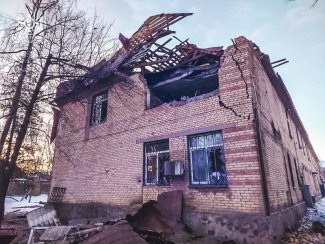Ninth massive Russian missile attack on Ukraine. 295th day of the war

On the morning of 16 December, Russia launched another missile attack on Ukrainian energy infrastructure. According to initial reports, facilities in the south and east of the country and in Kyiv and Korosten were damaged. However, energy supply interruptions (due to emergency shutdowns) occurred throughout the country. Of the larger cities, Kharkiv, Poltava, Kremenchuk and Kropyvnytskyi were completely cut off from power supply. However, serious problems were reported in Kyiv, Dnipro and Mykolaiv, among others, while Zaporizhzhia and Kryvyi Rih were also attacked.
According to media reports, by 9 am Kyiv time, the Russians were expected to have fired 72 missiles against Ukrainian energy infrastructure. Later, information from the Air Force Command mentioned more than 60 missiles of various types and the new tactics employed by the aggressor. In order to draw the attention of air defence systems to long-range cruise missiles from strategic bombers (Kh-555, Kh-101, Kh-22) and ships (Kalibr) and MiG-31 interceptor fighters (with Korzhal hypersonic missiles) manoeuvring near Ukrainian borders, the attackers fired shorter-range missiles: S-300s from ground launchers and Kh-59s from Su-35 multi-role combat aircraft. In the early afternoon, Commander-in-Chief of the Ukrainian Army General Valerii Zaluzhnyi reported that 60 of 76 enemy missiles (72 of which were cruise missiles) had been shot down.
Kyiv was the target of a kamikaze drone attack on 14 December. Few hits were reported in and around the city, and the Ukrainian side reported shooting down most (10–11) or even all 13 of the Iranian Shahed-136/131 drones attacking the capital. The Russians continue to strike Ukrainian army positions and facilities along the line of contact and border areas. On 13–15 December, they twice fired S-300 missiles at Kupiansk and Kostiantynivka, Kurakhove and Zaporizhzhia. On 12 December, Russian artillery conducted a massive shelling of Kherson and repeated strikes on the city in the following days. Due to the destruction of its infrastructure, it was completely de-energised. Nikopol and its surrounding villages, as well as the Ochakiv area, remained under permanent fire. On 15 December, the Russians shelled Kharkiv for the first time after a long pause. On the same day, Russian facilities in Donetsk were the target of Ukrainian shelling. Melitopol and its surroundings remain the main target of Ukrainian diversion.
The invading forces are attempting to attack Ukrainian positions in Donbas but have not had significant success. The main fighting areas are Bakhmut, Avdiivka, which is in danger of being encircled from the west, and towns west to Donetsk, mainly Marinka. Pressure has also increased on Ukrainian positions east of Siversk, on the border between Kharkiv and Luhansk oblasts (between Kupiansk and Svatove), and north and west of Kreminna. Ukrainian forces focused on counter-attacks and attempts to retake lost positions – in addition to the areas mentioned above, also in the western part of the Donetsk Oblast.
Germany has handed over to Ukraine, among other things, missiles for IRIS-T systems, two armoured recovery vehicles and 5,000 pieces of 155 mm artillery ammunition. France confirmed the transfer of six 155 mm TRF1 towed howitzers in recent months. With Italy, it has also decided to transfer Mamba medium-range air defence systems (SAMP-T). In turn, a new £50m package of British support included 125 previously announced anti-aircraft guns, drone countermeasures systems, radio reconnaissance, and combat measures. The Ukrainian authorities have reported launching and developing their production capacity for 152 mm and 155 mm artillery munitions.
So far, US media reports of a US decision to transfer Patriot air defence systems to Ukraine have not been confirmed. However, it is supposed to be prepared on the military side, and the problem remains its approval by the Department of Defence and President Joe Biden. Training future Ukrainian crews to operate the Patriot systems would take place at US Army facilities in Germany (under normal conditions, it takes at least six months).
In 2023, the UK intends to train 19,200 Ukrainian military personnel on its territory, mostly infantry soldiers and NCOs. As part of a programme with other allied countries, a total of nearly 10,000 soldiers are expected to receive training in the UK by the end of 2022. The Pentagon announced an increase in the scale of such exercises next year for Ukrainian soldiers based at the US force base in Germany. Nearly 500 soldiers per month (earlier media reports said 600 to 800) in the battalion structure will be improving in manoeuvre and combined arms operations. So far, the Americans have trained around 300 Ukrainian servicemen per month (by the end of this year, it will be a total of 3,100), mainly in handling transferred weaponry.
Ukrainian military intelligence reported on 12 December that since the beginning of the full-scale aggression, Russian armaments plants had produced 240 Kh-101 cruise missiles and about 120 Kalibr-type missiles. Despite Western sanctions, Russia continues to maintain production of cruise missiles at around 40 per month.
On 13 December, another unannounced test of the combat readiness of the armed forces with the participation of mechanised and special units was announced in Belarus. According to Alyaksandr Valfovich, Secretary of the Belarus Security Council, the task is to prepare the southern border defence. Exercises were also held in the Grodno area, and Minsk Oblast, where tasks related to forcing the Neman and Berezina were carried out. On the other hand, Kyiv did not record a concentration of forces ready to carry out an invasion on its border with Belarus. On 15 December, Deputy Chief of the Main Operational Directorate of the General Staff of Ukraine Oleksiy Hromov stated that the probability of an offensive enemy operation from the territory of the RB was low. Volunteers are being sought for territorial defence units in the Brest Oblast to defend localities in case martial law is imposed in Belarus.
The Ukrainian Special Operations Forces have confirmed that the Russian military company Wagner has recruited 23,000 prisoners. Assault troops used on the frontline in Donbas are being formed from them. According to the Ukrainian military, directing criminals into combat reduces the need to sacrifice qualified personnel. The heavy losses among the ‘volunteers’ are not met with adverse reactions among the Russians.
On 15 December, in an interview with The Economist, General Zaluzhnyi admitted that the available resources do not allow for large offensive operations, the problem being insufficient artillery and rocket ammunition. He stressed that the US Patriot systems would greatly reinforce the army, but training to operate them would be time-consuming. According to Zaluzhnyi’s assessment, the Russians are preparing 200,000 troops for combat and will likely launch a significant offensive in all directions in early spring. The general said that delivering 300 tanks, 600–700 infantry fighting vehicles and 500 howitzers is a prerequisite for effective action by Ukrainian forces. He suggested that the priority should be to seize Melitopol and cut the land connection with Crimea. On the same day, Defence Minister Oleksii Reznikov did not rule out that the enemy would launch an offensive as early as February 2023.
Commentary
- Russian attacks on critical infrastructure confirm that their main aim is to exhaust Ukrainians and attempt to convince them that efforts to stabilise the energy system and the relatively normal functioning of the state are doomed to fail. Once again, the missile strike comes at a time when the adversary is completing makeshift repairs and beginning to move to so-called scheduled power cuts. Indeed, the destruction of the energy infrastructure is already so great that restoring its normal functioning will not be possible until spring, and only if hostile attacks are halted. The systematic destruction of Kherson by the Russians should be viewed similarly. The aggressor’s moves are intended to demonstrate the Ukrainian side’s inability to ensure the safety of its residents, as well as to serve as a warning to other cities under occupation and within Russia’s annexation interests.
- The effectiveness of the attack tactics used by the invaders to confuse the enemy’s air defence systems remains an open question. The initial lack of information about the shoot-downs – especially in the Air Force Command communiqué, which has so far started the entire message with them – makes it possible to assume that the effectiveness of the attack may have been significantly higher than in previous cases. However, the shoot-down data transmitted a few hours later by General Zaluzhnyi does not deviate from the earlier average air defence effectiveness. This shows that the Ukrainian army has decided to maintain its current message, directed primarily at its own population, on the issue in question.
- The interview for The Economist is yet another example of the Ukrainian command abandoning its previous information policy, built on the euphoria of the success of the counter-offensive in Kharkiv Oblast and the recapture of Kherson. The military unequivocally points to shortfalls on the Ukrainian side and the systematic advantage built up by the Russians, which have led to a slowdown in offensive operations in recent weeks and threaten to see the enemy develop another offensive in the coming months. This should be seen not only as a sober assessment of the facts and an explanation for the lack of progress on the front – but also as a further appeal to the West to increase its support and, in particular, to provide a significant amount of modern offensive weaponry.
- The holding of further unannounced exercises in Belarus is intended to manifest the country’s readiness to defend itself not so much against Ukraine as against NATO countries. Indeed, exercise activity has been reported in areas far from the southern border, including around Grodno. Keeping the armed forces on standby is also a political gesture by the regime towards Moscow. Vladimir Putin is due to arrive in Minsk on 19 December, and during the talks, the ‘combat capability’ of the armed forces and defence industry cooperation is to be discussed. This indicates that Russia is primarily concerned with maximising the use of Belarusian logistical facilities to develop further and train its troops. A no less critical thread is also the adaptation of the production of the local arms industry to the needs of the Russian army.





